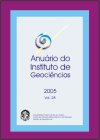Ontogeny stages of Mariliasuchus amarali, Crocodyliformes Mesosuecrocodylia from Adamantina formation, upper cretaceous of Bauru Basin, Brazil
DOI:
https://doi.org/10.11137/2005_1_49-69Abstract
Mariliasuchus amarali Carvalho & Bertini, 1999 , a Mesoeucrocodylia from the Adamantina Formation (Bauru Basin, Upper Cretaceous) shows some adaptative features to terrestrial environments: short and high skull, lateral orbits, frontal external nares and reduction of the dental formula with specialization of the tooth crown morphology in incisiform, caniniform and molariform teeth. It has been included in the infraorder Notosuchia Gasparini, 1971. Three specimens of Mariliasuchus amarali, found near the municipality of Marília, São Paulo State were analysed. One of them, holotype of Mariliasuchus amarali (UFRJ DG 50-R), is a juvenile crocodylifom whereas the other two (UFRJ DG 105-R and UFRJ DG 106-R) are adult animals. These fossils allowed an analysis of the ontogenetic development patterns of this species. It was performed a comparison betweeen the mandibular, laterotemporal and supratemporal fenestrae and the skull sculpturing in the three specimens. The results show that Mariliasuchus acquire in the course of its ontogeny a thicker and stronger skull. The caudal migration of the laterotemporal fenestra and the size increase of the supratemporal fenestra probably indicate a wider use or strength of the adductor muscles during seizing and food processing.Downloads
Download data is not yet available.
Downloads
Published
2005-06-01
How to Cite
Vasconcellos, F. M. de and Carvalho, I. de S. (2005) “Ontogeny stages of Mariliasuchus amarali, Crocodyliformes Mesosuecrocodylia from Adamantina formation, upper cretaceous of Bauru Basin, Brazil”, Anuário do Instituto de Geociências. Rio de Janeiro, BR, 28(1), pp. 49–69. doi: 10.11137/2005_1_49-69.
Issue
Section
Article
License
This journal is licensed under a Creative Commons — Attribution 4.0 International — CC BY 4.0, which permits use, distribution and reproduction in any medium, provided the original work is properly cited.















